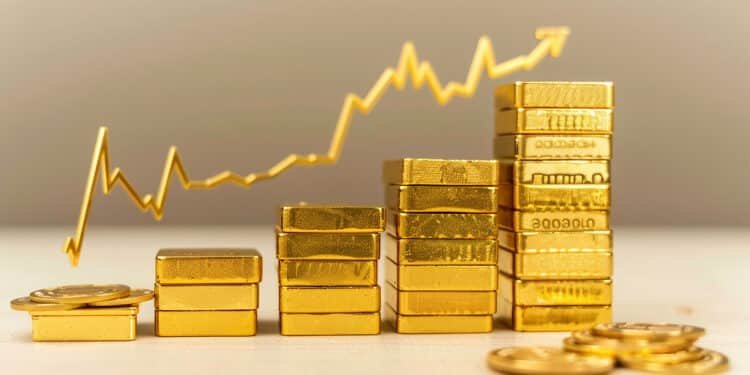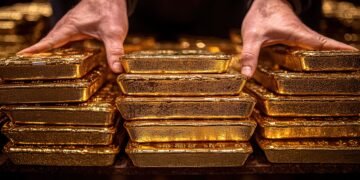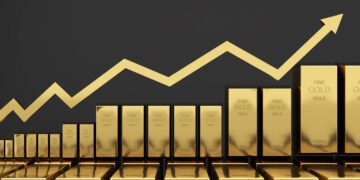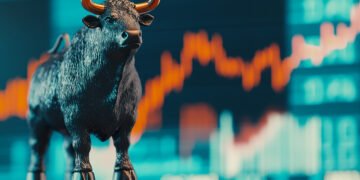Gold has delivered an exceptionally strong performance in the first half of 2025, achieving a remarkable 26% gain that positions the precious metal as one of the year’s standout investment assets. This impressive rally has been driven by a confluence of factors including a weakening U.S. dollar, persistent geopolitical tensions, robust investor demand, and continued strategic purchasing by central banks worldwide. As markets transition into the second half of the year, the World Gold Council’s comprehensive mid-year outlook report, published on Tuesday, July 15, provides crucial insights into the complex dynamics that will likely shape gold’s trajectory through the remainder of 2025.
First Half Success: A Foundation Built on Multiple Pillars
The 26% surge in gold prices during the first six months of 2025 represents one of the strongest opening performances for the precious metal in recent years. This substantial appreciation has been underpinned by several interconnected market forces that have aligned to create favorable conditions for gold investment.
The weakening U.S. dollar has played a central role in gold’s ascent, as the inverse relationship between dollar strength and gold prices continues to be a dominant market dynamic. When the dollar loses value relative to other major currencies, gold becomes more attractive to international investors and appears cheaper to holders of foreign currencies. This fundamental relationship has provided consistent support for gold prices throughout the first half of the year.
Interest rates have remained in a relatively constrained range, creating an environment where the opportunity cost of holding non-yielding assets like gold has been minimized. When interest rates are stable and relatively low, investors face less pressure to abandon gold in favor of yield-producing alternatives, allowing the precious metal to maintain its appeal within diversified portfolios.
The highly uncertain geoeconomic environment has generated strong investment demand as investors seek safe-haven assets to protect against various forms of market and political risk. This uncertainty encompasses not only traditional geopolitical tensions but also evolving trade relationships, regulatory changes, and economic policy uncertainties that have kept investors on edge throughout the first half of the year.
Central bank purchasing has provided another crucial pillar of support, with monetary authorities around the world continuing their strategic accumulation of gold reserves as part of broader efforts to diversify their holdings away from traditional reserve currencies and enhance their financial sovereignty.
Second Half Challenges: Navigating the Seesaw
The World Gold Council characterizes the second half of 2025 as sitting “on a seesaw,” reflecting the delicate balance of forces that will determine gold’s future performance. This metaphor captures the reality that while many of the factors supporting gold’s first-half performance are expected to persist, the market faces significant uncertainty about how various economic and geopolitical developments will unfold.
Geoeconomic uncertainty continues to keep investors on edge, with persistent concerns that global conditions could deteriorate rapidly and unexpectedly. These concerns are not merely theoretical—the past several months have demonstrated how quickly market sentiment can shift in response to geopolitical developments, trade negotiations, or unexpected policy announcements.
Dollar-related pressures are likely to persist throughout the second half, potentially providing continued support for gold prices. The World Gold Council specifically notes that questions around “the end of US exceptionalism” may dominate investor discussions, suggesting that concerns about America’s economic and financial dominance could continue to influence currency markets and, by extension, gold demand.
However, the council also acknowledges that gold prices have already captured part of these favorable dynamics, suggesting that some of the potential upside may already be reflected in current valuations. This observation highlights the challenge facing gold investors: while fundamental conditions remain supportive, the extent to which these conditions can drive further price appreciation may be limited by the market’s existing recognition of these factors.
Scenario Analysis: Multiple Paths Forward
To provide comprehensive guidance for the second half of 2025, the World Gold Council’s team of specialists analyzed gold’s prospects across multiple scenarios, examining the precious metal’s four key drivers: economic expansion, risk and uncertainty, opportunity cost, and momentum.
The Consensus Scenario suggests a relatively steady finish for gold with moderate upside potential if current macroeconomic conditions hold. Under this baseline scenario, market consensus expectations indicate that global GDP will move sideways and remain below trend growth rates in the second half of the year. This environment of sluggish but stable growth would likely maintain investor interest in alternative assets like gold while avoiding the extreme conditions that could drive dramatic price movements in either direction.
Inflation dynamics play a crucial role in this consensus scenario, with world inflation positioned to likely rise above 5% as the global impact of tariffs becomes more pronounced. Market expectations suggest that U.S. Consumer Price Index inflation will reach 2.9%, creating a complex environment where inflation concerns support gold demand while still remaining below levels that would trigger aggressive policy responses.
In response to this mixed economic backdrop, central banks are anticipated to begin cautiously lowering interest rates toward the end of the fourth quarter. The Federal Reserve is expected to implement a probable 50 basis point rate cut by year-end, which would reduce the opportunity cost of holding gold and potentially enhance its appeal relative to yield-producing alternatives.
The Upside Scenario envisions significantly higher gold prices driven by more volatile geopolitical and geoeconomic conditions. Under this scenario, substantial stagflation or recession risks could materialize, dramatically increasing investor appetite for safe-haven assets. The combination of persistent inflation with economic contraction would create precisely the type of environment where gold has historically performed exceptionally well, as investors seek protection from both currency debasement and economic uncertainty.
The Downside Scenario acknowledges that while seemingly unlikely given current conditions, widespread and sustained global trade normalization could challenge gold’s momentum. Such an outcome would likely bring higher yields and resurgent risk appetite, as improved trade relationships and reduced geopolitical tensions would encourage investors to move toward riskier, higher-yielding assets. Additionally, a visible deceleration in central bank demand beyond current expectations could remove one of the key pillars supporting gold prices.
Investment Demand and Institutional Participation
The World Gold Council expects continued strong investment demand driven by falling interest rates and persistent uncertainty. This demand is likely to manifest particularly through gold exchange-traded funds and over-the-counter transactions, which provide investors with efficient mechanisms for gaining gold exposure without the complexities of physical ownership.
An intriguing development mentioned in the outlook is the potential contribution from new institutional investors, specifically Chinese insurance companies. This expansion of institutional participation could provide additional demand that helps support gold prices, particularly if these institutions view gold as an attractive diversification tool or hedge against domestic economic and currency risks.
The technical analysis perspective suggests that gold’s recent consolidation phase represents a healthy pause within a broader uptrend. This consolidation has helped ease previous overbought conditions while potentially setting the stage for renewed upside momentum if fundamental conditions remain supportive.
Central Bank Activity and Consumer Dynamics
Central bank demand for gold is expected to remain robust throughout 2025, though the World Gold Council anticipates some moderation from previous record levels. Despite this expected decrease from peak purchasing rates, central bank accumulation is projected to stay well above the pre-2022 average range of 500 to 600 tonnes annually.
This continued institutional demand reflects ongoing efforts by monetary authorities to diversify their reserve holdings, reduce dependence on traditional reserve currencies, and enhance their financial resilience against various forms of economic and political pressure. The strategic nature of central bank gold purchases suggests that this demand source is likely to persist regardless of short-term price fluctuations.
However, elevated gold prices present challenges in other market segments. The World Gold Council notes that high prices are likely to continue curbing consumer demand, particularly in price-sensitive markets where gold jewelry and other consumer applications face competition from lower-priced alternatives.
Additionally, elevated prices may encourage increased recycling activity, as higher gold values make it more attractive for consumers to sell existing gold items. This potential increase in recycled gold supply could partially offset strong investment and central bank demand, creating a more complex supply-demand dynamic that could limit the extent of future price appreciation.
Trade Tensions and Geopolitical Factors
The outlook acknowledges that while some advance in trade negotiations is anticipated, the overall environment will likely remain volatile, consistent with patterns observed over recent months. Geopolitical tensions, particularly between the United States and China, are expected to remain elevated throughout the second half of 2025, contributing to a generally uncertain market environment that favors safe-haven assets like gold.
These ongoing tensions extend beyond simple trade disputes to encompass broader questions about global economic leadership, technological competition, and the evolution of international monetary systems. Such comprehensive sources of uncertainty create conditions where gold’s role as a neutral, politically independent store of value becomes particularly attractive to investors and institutions alike.
Strategic Investment Positioning
The World Gold Council concludes its analysis by emphasizing gold’s continued relevance for both tactical and strategic investment decisions in the current macroeconomic landscape. The organization acknowledges the inherent limitations of economic forecasting while maintaining that gold’s fundamental characteristics position it well to serve investor needs regardless of which specific scenario unfolds.
This perspective reflects gold’s unique position as an asset that can provide portfolio benefits across a wide range of economic conditions. Whether serving as a hedge against inflation, a safe haven during geopolitical stress, or a diversification tool during periods of financial market volatility, gold’s multifaceted appeal helps explain its continued relevance in professional investment portfolios.
The council’s analysis suggests that while gold faces various challenges and uncertainties in the second half of 2025, the fundamental drivers supporting the precious metal remain intact. The key question for investors is not whether gold will continue to play an important role in global markets, but rather how external conditions will influence the magnitude and timing of future price movements.
As markets navigate the complex array of economic, political, and financial factors that will shape the remainder of 2025, gold’s performance will continue to serve as a barometer of global investor confidence and economic stability. The World Gold Council’s outlook provides a framework for understanding these dynamics while acknowledging the inherent uncertainty that makes gold both challenging and potentially rewarding as an investment asset.
Acknowledgment: This article was written with the help of AI, which also assisted in research, drafting, editing, and formatting this current version.







